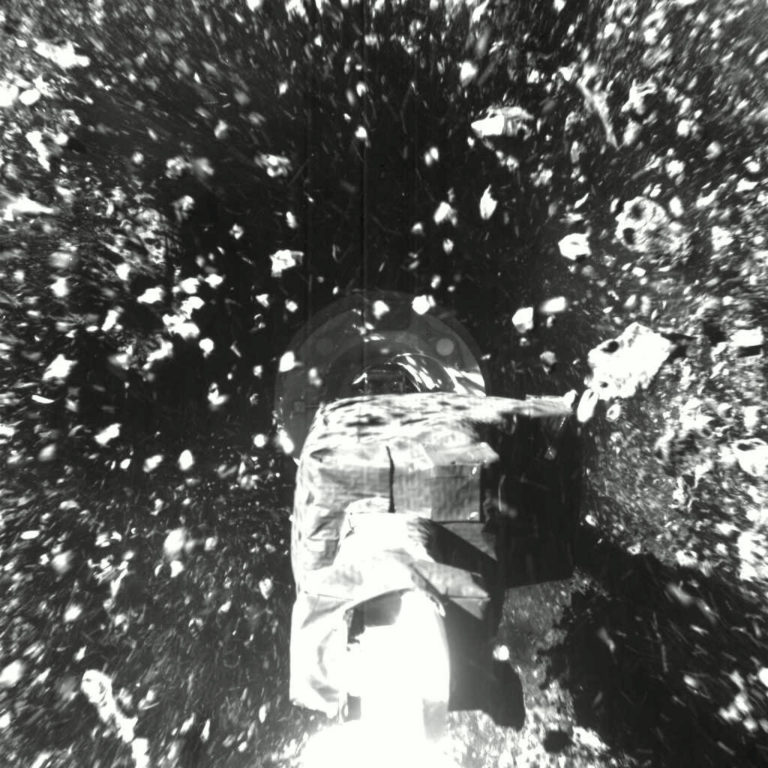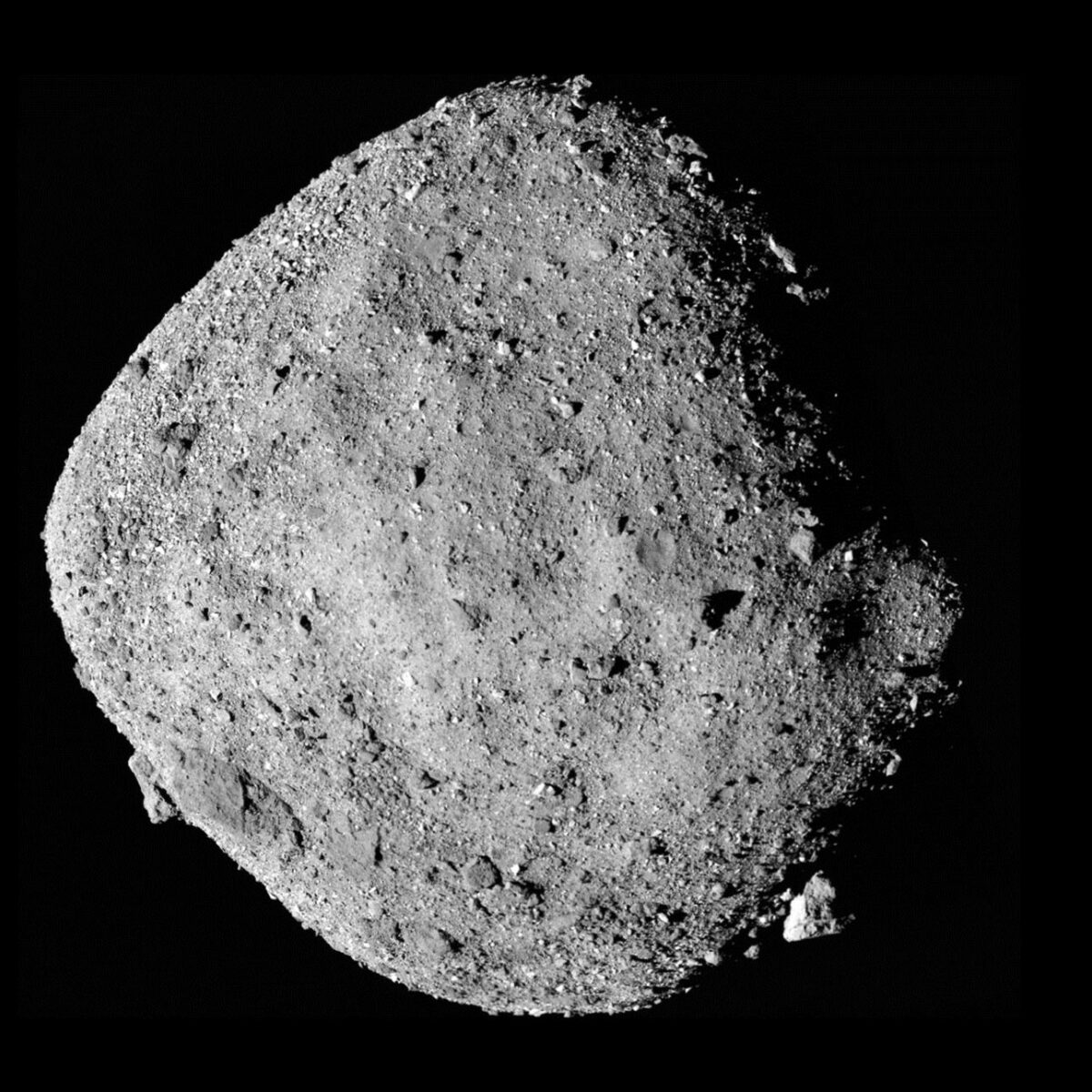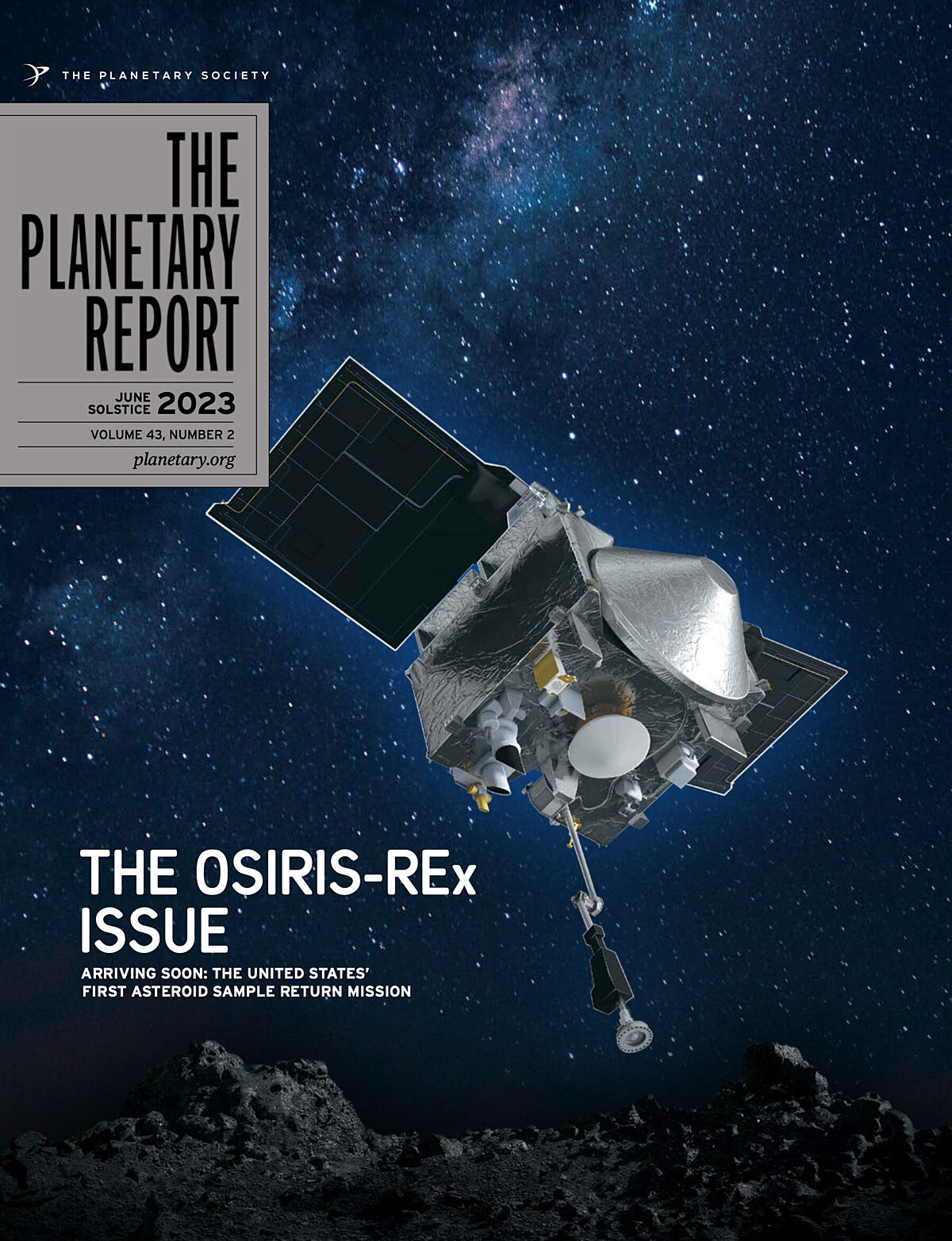
On the Cover: Artist’s rendition of the OSIRIS-REx spacecraft at Bennu.
Download PDF
Features
June Solstice 2023
Why did we need OSIRIS-REx?
How OSIRIS-REx’s samples build upon our knowledge of asteroids and the early Solar System.
Asteroid samples from another world
The OSIRIS-REx team explains the journey home.
Your impact: June solstice 2023
Meet our second round of STEP Grant winners!
Your place in space
A cosmic emissary makes its way back home: OSIRIS-REx is coming back to Earth with all of us on board in spirit — and for many of us, in name
By Bill Nye, Planetary Society CEO
Come September of this year, a small amount of material from asteroid Bennu aboard NASA’s OSIRIS-REx (that’s the Origins Spectral Interpretation Resource Identification, Security, Regolith Explorer) spacecraft will come hurtling back to Earth (in Utah in the United States). I was at the launch in Cape Canaveral, which took place a little after 7:00 p.m. local time on Sept. 8, 2016. It was a picture-perfect flight that left a smoke trail from the exhaust and a perfectly straight dark shadow against a gorgeous blue Florida sky.
Bennu was named by Planetary Society member Mike Puzio, who was only in third grade at the time. He won the naming contest that The Planetary Society helped organize. NASA administrator Charlie Bolden met him at the launch and shook his hand. It was quite an evening.
OSIRIS-REx has been flying for the last 6 1/2 years. To get all the way to Bennu, it swung by Earth for a gravity assist. It managed to spend a year and a half (505 Earth days) at Bennu, taking pictures and finding a place suitable for a robotic arm scoop-by (that is my own coinage). Then, it went back to Bennu orbit before pogo-sticking (mission manager’s coinage) into a return-to-Earth orbit.
The O in OSIRIS stands for Origins — our origins. Asteroids come in a variety of types with a variety of characteristics. Bennu, believed to have formed at the very beginning of our Solar System, has a great deal of carbon. That suggests it may have organic compounds, which in turn suggests it may have some of the fundamental molecules found in the organisms that are alive today. If we can find organic molecules aboard this species of asteroid, it may have remarkable implications about the origin of living things — like us.
The S in OSIRIS stands for Security. We want to learn about the orbits of objects like Bennu so we can prepare in case there’s one incoming. We want our home to be secure. Stay tuned. Bennu has a slim chance of impacting Earth in the year 2182. With this mission, we’ll learn more about asteroids and their orbits and how they may cross ours someday.
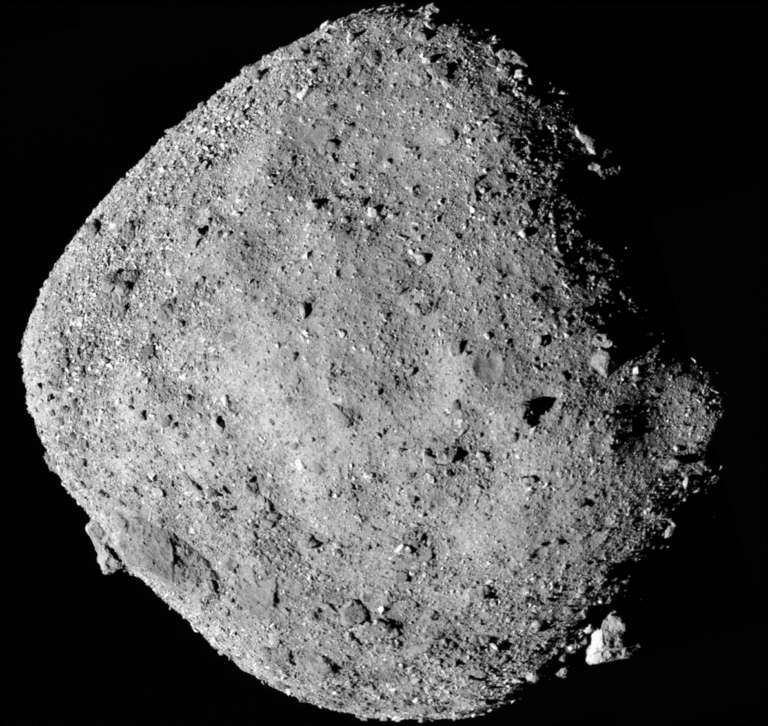
On board with the precious sample of regolith, there’s a microchip
carrying 442,803 encoded names of people like you. One might wonder why
the people leading a mission to bring home such valuable cargo would
bother adding something as seemingly frivolous as a collection of names.
These names represent something deeply important. We sent this
spacecraft out into the Solar System for the sake of all of us. Every
mission to explore space serves as an emissary for all of humankind, and
the discoveries OSIRIS-REx will enable will benefit everyone here on
Earth.
This is why The Planetary Society has a longstanding
tradition of collecting names to send aboard spacecraft, including
OSIRIS-REx. We want to emphasize the fact that everyone on this planet
has a role to play in space exploration and that when a mission heads
out into the Cosmos, we go with it in spirit.
Once OSIRIS-REx
parachutes its Bennu sample back to Earth, scientists in the United
States and around the world will start studying those little pieces of
asteroid. As you’ll read later in this issue, we’ve never collected
material from this kind of asteroid before, so we don’t yet know exactly
what we’ll discover. But when that new science does start coming in,
we’ll make sure you hear all about it and share in the wonder it
inspires.
As a Planetary Society member, you share in missions like OSIRIS-REx. You help make them happen. You help these missions get funded, stay funded, and make it to the launch pad. You also help spread awareness of these amazing missions and the things they teach us about the Cosmos, inviting new people to experience the joy of exploration and discovery.
Members on deck
Our hopes for OSIRIS-REx
In our brand-new member community, Planetary Society members shared their excitement about the return of samples from OSIRIS-REx. Haven’t joined the member community yet? Don’t miss out. It’s our newest perk for Planetary Society members: a place where you can learn about space and connect with a global community of space enthusiasts. Log in today at community.planetary.org.
"Not only do I hope we can learn how to better explore our local blip in the Universe but I hope we will learn more about our origins as well as the early life of our lil’ blue dot. Whether it's evidence of organic molecules being ever present from the earliest times of Earth’s existence or evidence that suggests our most base of building blocks was delivered from elsewhere, pummeling our planet with some “tough love” to get it ready to host life as we know it, I hope we will learn and seek more knowledge as a result." — Alonzi Smyth, USA
"I think I’m not alone in hoping that we will learn that asteroids like Bennu have complex organic life-building blocks. And I hope we learn more about water on Bennu." — Robert Johannessen, Norway
"I hope we learn if it is a fragment of a former planet, captured space debris from outside our Solar System, or anything that advances our knowledge of space." — Alan Briley, USA
"I’d love to learn more about Bennu’s history, if its geology is in fact comparable to that of the Mars/Jupiter belt, and how it may have affected Earth in the past." — Luke Dunlop, USA
"I hope that we will learn about new elements and if there is any organic material." — Joe Salinas, USA
Get involved
Save the date for our eclipse festival
A total solar eclipse will dazzle spectators living in North America on April 8, 2024. The Planetary Society will be offering you an unforgettable viewing experience from the Texas hill country. The next opportunity to see a total solar eclipse in the U.S. won't come again for another 20 years, making this an event not to be missed. Start planning now to ensure you you're able to join us and see this breathtaking cosmic event. For more information, visit planetary.org/eclipse.

Sign up for the Day of Action
The Planetary Society’s Day of Action will be coming back to Washington, D.C., this year for the first time in three years. On Sept. 18, advocates from across the United States will come together to meet with their representatives and express their strong support for investments in NASA’s planetary science, exploration, and planetary defense missions. This is one of the most impactful ways you can speak up for space, so if you live in the United States and want to do more to support NASA, sign up for the Day of Action today. For members in other countries, stay tuned for email updates about how you can take part in the Day of Action no matter where you live. To learn more, visit planetary.org/dayofaction.
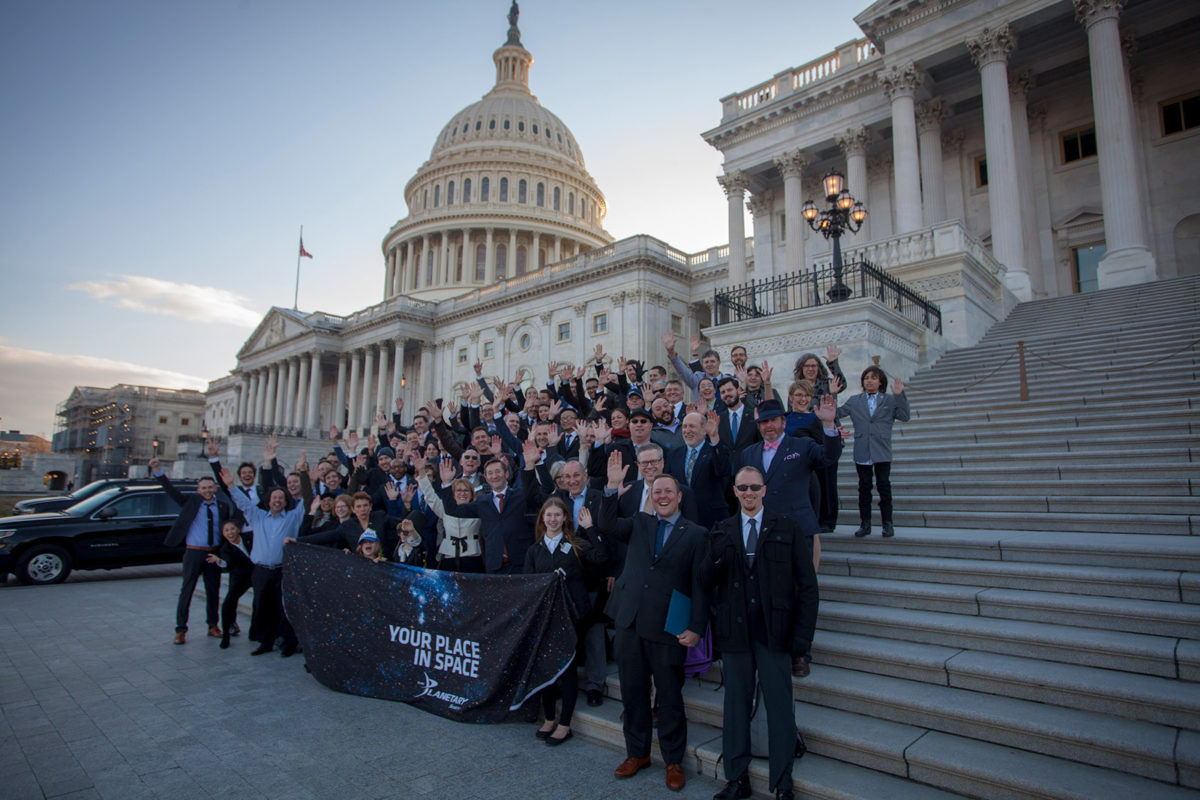
Join your member community!
The Planetary Society is proud to offer our members a brand-new, exclusive online community. More than 3,500 members have already joined. You should too!
Via web browser or app, Planetary Society members around the world can use this interactive virtual space to connect with each other as well as world-class space experts and Planetary Society staff and spokespeople. Members can read and discuss our latest articles, take free online courses, and share tips and tools for all the things space enthusiasts do, from community outreach to astrophotography to advocacy to artwork and so much more.
This is your place in space. It’s where you can collaborate with people who share your interests, passions, and goals. It’s where you can deepen your knowledge of the Cosmos and our efforts to explore it. And it’s where you can have fun and make friends with like-minded people from around the world.
The Planetary Society is at its core just that: a society. We started as a small group of individuals, but in the decades since our founding, our membership has grown around the planet. We are people of all nationalities, ages, and walks of life, united by a shared belief in the value of space science and exploration. This new platform gives this society a place to meet, to work together, and to accomplish more than we can as individuals. The digital member community is something we’ve been working toward for a long time, and we’re excited to see our members already making the most of it.
Check it out now at community.planetary.org.

Do your part to find E.T.
SETI, the search for extraterrestrial intelligence, encompasses many different techniques to look for life beyond Earth. One is listening for radio transmissions from other star systems. Detecting these signals is challenging because we have to rule out signals from intelligent life right here on Earth. Computer algorithms can sift through large amounts of data and hone in on promising signals, but these programs must be trained to discard false positives.
That’s where volunteer scientists come in. Researchers at UCLA in partnership with The Planetary Society and NASA are recruiting volunteers to train computer algorithms that will be used to search for life beyond Earth. Using the Zooniverse citizen science platform, volunteers examine signals captured by the 100-meter (328-foot) Green Bank Telescope that are coming from 100 stars known to have planets. Participants sort signals into categories of known radio interference, which will then help train a machine-learning system for future searches.
The Planetary Society awarded $50,000 to the project through our STEP Grants program in 2022, and we invite all our members to take part. You can sort one signal or a thousand! It’s up to you. Sign up today at arewealone.earth.
The Planetary Society book club
One of the great new activities taking place in the member community is our new monthly space book club. Hosted by Planetary Radio creator Mat Kaplan, this online club will bring you ongoing discussions about each month’s book, culminating in a live virtual event featuring a conversation and Q&A with the author or a relevant space expert. Find the book club and more at community.planetary.org.
Celebrate Asteroid Day!
The Planetary Society is proud to partner with Asteroid Day, an international celebration of all things asteroid, from the science of space rocks to the efforts to protect our planet from impacts. Asteroid Day takes place on June 30 every year and involves virtual and in-person events around the world. Go to asteroidday.org to learn more and join the party!
VERITAS needs your help
NASA’s first Venus orbiter in three decades is facing an indefinite delay. The Venus Emissivity, Radio Science, InSAR, Topography, and Spectroscopy (VERITAS) mission was selected by NASA in 2021 as the U.S.’s first Venus orbiter since 1989. The project was on time and on budget. However, in the latest President’s Budget Request, NASA slashed the mission’s funding to nearly zero dollars and indefinitely delayed the launch. NASA admits this decision was due to cost overruns and workforce issues in other programs. We need space advocates like you to voice your support for a renewal of VERITAS funding. If you live in the United States, send a letter to your representatives in Congress urging them to ensure that this important mission gets off the ground. Go to planetary.org/action-center.
What's up?
A great year to see the Perseids
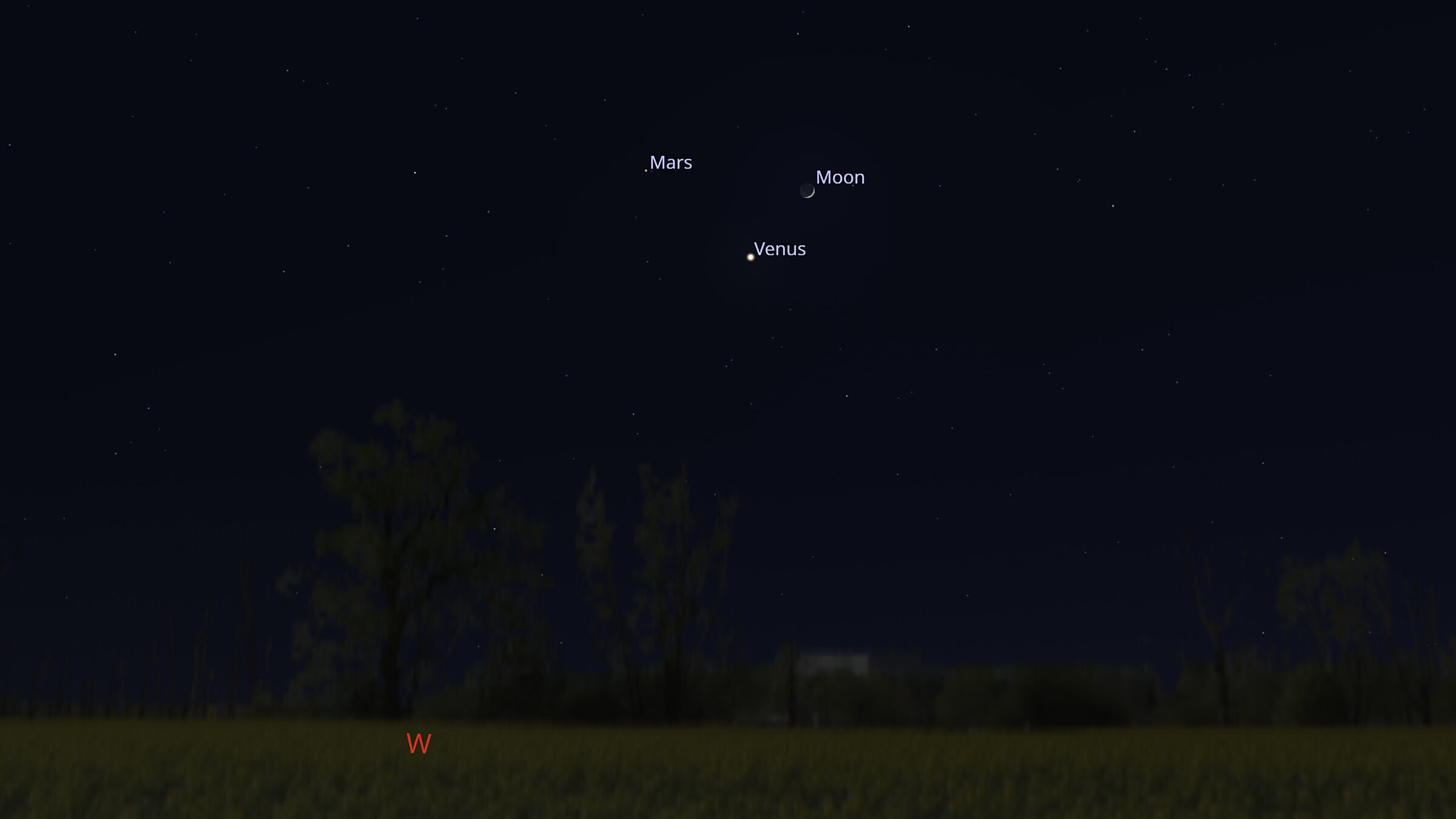
By Bruce Betts, Planetary Society Chief Scientist
In the sky
In June and July, super-bright Venus and dimmer reddish Mars are low in the west in the early evening. The crescent Moon joins them in a tight grouping on June 21. Yellowish Saturn is above bright Jupiter in the pre-dawn, starting low to the horizon in June but then getting higher as the weeks pass. By September, Venus has moved to the pre-dawn east. The Perseid meteor shower, usually one of the top meteor showers of the year, peaks Aug. 12/13, with increased activity several days before and after. It is a great year to see the Perseids because there will be little interference from moonlight, as there is only a crescent moon that rises not long before dawn. From a very dark site, there are typically 50 to 75 meteors per hour at the peak.
Random space fact
The mass of rocks and dirt brought back from the Moon by astronauts in the Apollo program is equivalent to about 21 granite rocks (stones) used in the sport of curling.
Trivia contest
Our December solstice contest winner is Herbert Teitelbaum of Brooklyn, New York, USA. Congratulations! The question was: How many hexagonal segments make up the JWST primary mirror? The answer: 18.
Try to win a copy of the new book “Solar System Reference for Teens” by Bruce Betts and a Planetary Radio T-shirt by answering this question: On the asteroid Bennu, what were the names the OSIRIS-REx team assigned to the final four sampling sites they considered before choosing one of them to sample?
Email your answer to [email protected] or mail your answer to The Planetary Report, 60 S. Los Robles Ave., Pasadena, CA 91101. Make sure you include the answer and your name, mailing address, and email address (if you have one). By entering this contest, you are authorizing The Planetary Report to publish your name and hometown. Submissions must be received by Sept. 1, 2023. One entry per person. The winner will be chosen in a random drawing from among all the correct entries received. For a weekly dose of What’s Up? complete with humor, a weekly trivia contest, and a range of significant space and science fiction guests, listen to Planetary Radio at planetary.org/radio.
Astronomical art
Disturbing an asteroid
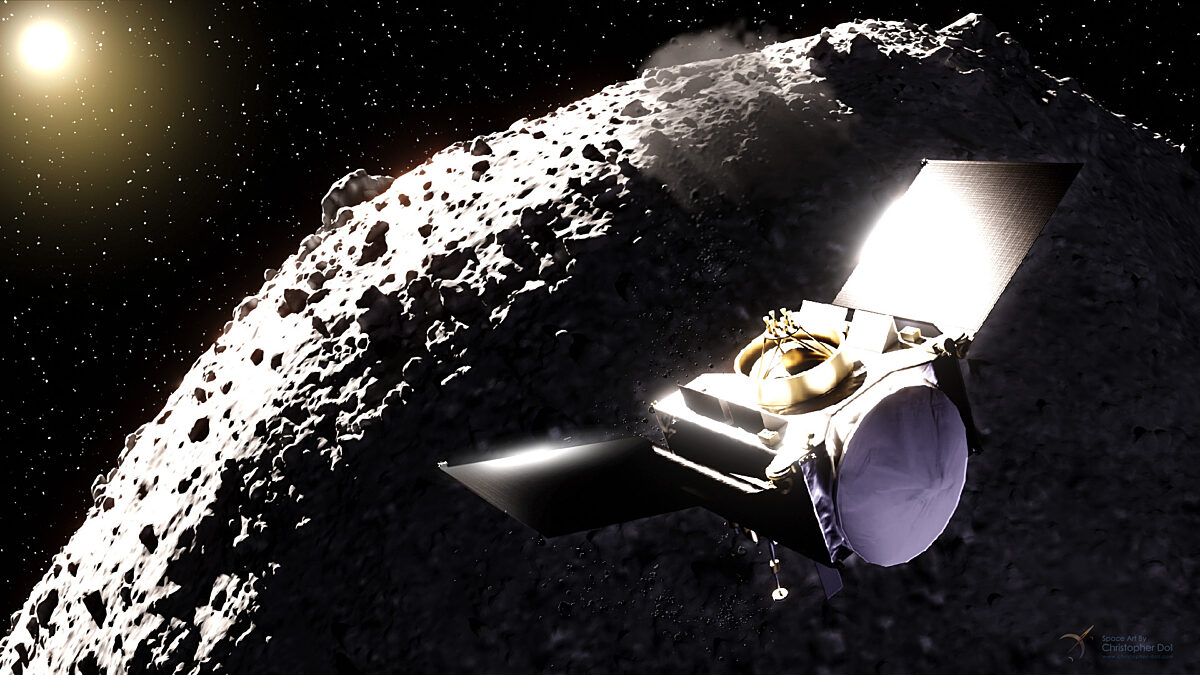
This artwork from International Association of Astronomical Artists member Christopher Doll shows OSIRIS-REx approaching the asteroid Bennu with the Sun shining in the background. “I wanted to capture the aftermath of OSIRIS-REx’s sample retrieval from asteroid Bennu,” said Doll, “with a hint of escaping debris as it sped on its way back to orbit. To the surprise of many, myself included, Bennu’s surface wasn’t nearly as solid as anticipated. We were left with a new understanding of the composition of asteroids. The image was constructed using available 3D data on the asteroid Bennu and the OSIRIS-REx spacecraft. I used Blender3D to compose the elements in this dramatic scene. Final details and adjustments were added in Photoshop.”
Do you want to see your artwork here? We love to feature our members throughout this magazine. Send your original, space-related artwork to [email protected].
The Planetary Report • June Solstice 2023
Help advance space science and exploration! Become a member of The Planetary Society and you'll receive the full PDF and print versions of The Planetary Report.


 Explore Worlds
Explore Worlds Find Life
Find Life Defend Earth
Defend Earth


